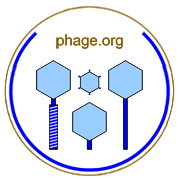

A measure of the rate at which free phages become attached to bacteria.
Technically the adsorption constant, or adsorption rate constant, is the probability of adsorption of a single phage to a single bacterium, both suspended in a single unit volume of fluid over a single unit of time. That is, for example, per min and per ml, or per hour and per ml (though often this is shown instead as ml min-1 = ml/min = cm3/min, etc., or ml hr-1 = ml/hr, etc.).
Typically adsorption constants are determinations of rates of irreversible rather than reversible adsorption to bacteria. A typical value is in the range of 10-8 to 10-9 ml min-1. Since units of ml/hr are also commonly used, note that that 60 × X ml/min = Y ml/hr.
The phage adsorption constant represents a complicated parameter combining phage diffusion rates, bacterial target size, and phage affinity for bacteria. Increases in any of these parameters will result in increases in the phage adsorption constant. The constant is independent, however, of both phage and bacterial densities, though at very high bacterial densities delays in transitions from reversible to irreversible adsorption may occur more slowly than rates of phage adsorption, potentially resulting in an inability to calculate the latter from adsorption-rate information.
Determinations of adsorption rates and thereby adsorption constants ideally involves kinetic measurements of either phage removal from the free phage state or phage gain of the adsorbed state. The former can be misleading, however, when working with poorly defined systems such that free phage loss can occur for reasons other than phage adsorption. See, for example, adsorption efficiency.
For additional discussion and references, see Abedon (2011), Kropinski (2010), and Hyman and Abedon (2009).
For more on this topic, see Wikipedia, Google, and PubMed. Contact web master. Return to terms.